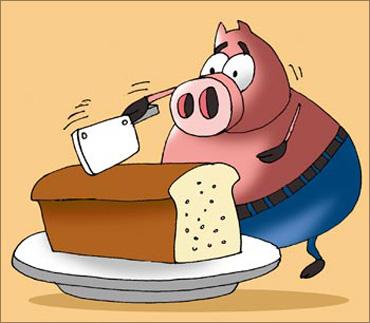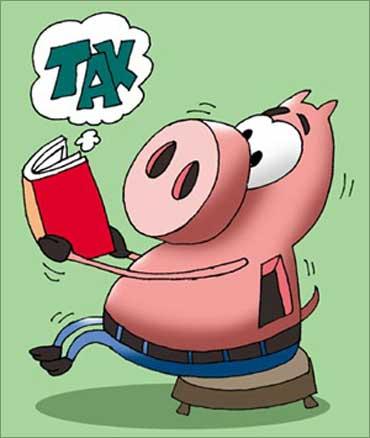 | « Back to article | Print this article |
Budget: Will the govt tinker with income tax?
The government is likely to plug loopholes in international taxation to swell its kitty, since it does not have too many options to raise taxes in the upcoming Budget due to proposed rates in new direct and indirect tax regimes and high inflation.
Rising inflation is not only hitting the common man, but will also make the task of the government to increase its tax-GDP ratio difficult, sources said.
Facing this difficult task, the government may try to strengthen its international taxation rules like Mutual Agreement Procedures (MAP), transfer pricing, revision in double taxation avoidance agreements to make its exchequer richer in 2011-12.
This will also be done because the government is also not expected to get ANY windfall from non-tax revenue next fiscal, as it received this fiscal from the sale of spectrum for high speed mobile and broadband services.
The Centre received Rs 75,000 crore (Rs 750 billion) more than the budget estimates on this count. With a target to bring down fiscal deficit to 4.8 per cent of GDP during 2011-12 from the estimated 5.5 per cent this fiscal, the government has to see for more revenues or cut its expenditure.
Click NEXT to read what the Budget might have in store on the personal income tax front. . .
Budget: Will the govt tinker with income tax?
On revenue front, the hands of the government are tied since it has already proposed new tax slabs in the Direct Taxes Code Bill, currently with the standing committee of Parliament.
In the DTC Bill, introduced by Union Finance Minister Pranab Mukherjee last year, the government seeks to widen tax slabs to levy 10 per cent rate on income between Rs 2 lakh (Rs 200,000) and 5 lakh (Rs 500,000), 20 per cent on Rs 5-10 lakh (Rs 500,000-Rs 1 million) and 30 per cent above Rs 10 lakh.
Currently, income between Rs 1.6-5 lakh (Rs 160,000-500,000)attracts 10 per cent tax; Rs 5-8 lakh (Rs 500,000-800,000)20 per cent and beyond Rs 8 lakh 30 per cent.
The government is likely to retain these rates and wait for DTC Act to come into force from April 1, 2012.
However, it may tinker with threshold limit, sources said. Since it is also in talks with states to bring Goods and Services Tax from the same date, the government might also not change indirect tax rates.
Click NEXT to read further. . .
Budget: Will the govt tinker with income tax?
The Centre has proposed higher 10 per cent tax on goods (each from the Union and state government's side) and lower 6 per cent tax.
Besides, it suggested that services should attract 8 per cent rate by the Centre and states each. All these rates are suggested to move to 10 per cent over three- year period.
Though not much breakthrough is happening on negotiations with states on GST, the government is likely to keep indirect taxes unchanged to give signal about its commitment to the new indirect tax regime, sources said.
However, it should be noted here that GST would not replace customs duty. Here also the government is likely to refrain from raising the rate because of high inflation. In fact, most food items already have nil customs duty, the source said.
The government has recently removed five per cent customs duty and four per cent countervailing duty on onion after its retail prices skyrocketed to Rs 75-80 across the country.
Click NEXT to read further. . .
Budget: Will the govt tinker with income tax?
Since then, prices have eased a bit. High inflation is also likely to send the government plans to increase its tax-GDP ratio into a tailspin.
This is so because tax-GDP ratio is calculated on nominal size of the economy. It means that if the economy grows by say nine per cent and inflation by 10 per cent, nominal GDP would be 19 per cent, making it difficult to raise the tax-GDP ratio.
The sources said rising GDP would not yield so much on taxes front to raise tax-GDP, if inflation continues to be at high levels.
Tax-GDP ratio had risen to over 11 per cent during 2007-08 from 8.2 per cent in 2001-02, but has since then declined to about 10 per cent last fiscal.
As such, the government will try to settle more cases under MAP, seek consultations from those who have specific knowledge of transfer pricing and revise double taxation avoidance agreement with countries to seek details of money evasion, the sources said. MAP refers to a dispute settlement mechanism of MNCs having offices in India.
Click NEXT to read further. . .
Budget: Will the govt tinker with income tax?
The sources said more than Rs 7,000 crore (Rs 70 billion) was received under MAP in the last one year, and this amount may increase manifold in the coming years.
Recently, India and the United States signed a memorandum of understanding for resolving cases under MAP.
The resolution of disputes under MAP basically relates to transfer pricing rules. Transfer pricing rules refers to calculation of taxes of MNCs in different countries.
The sources also said India is currently renegotiating 65 double taxation avoidance agreements out of total 79 to revise secrecy clause, so that tax evasion could be checked.
DTC also has proposals like controlled foreign corporates and general anti-avoidance rule (GAAR) to plug in loopholes in international taxation.




